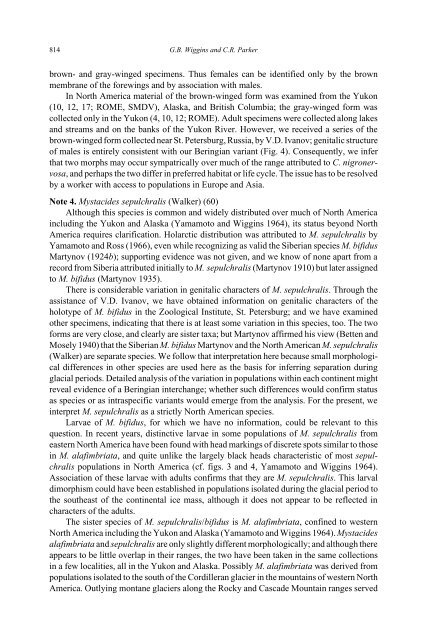Caddisflies of the Yukon - Department of Biological Sciences ...
Caddisflies of the Yukon - Department of Biological Sciences ...
Caddisflies of the Yukon - Department of Biological Sciences ...
You also want an ePaper? Increase the reach of your titles
YUMPU automatically turns print PDFs into web optimized ePapers that Google loves.
814 G.B. Wiggins and C.R. Parker<br />
brown- and gray-winged specimens. Thus females can be identified only by <strong>the</strong> brown<br />
membrane <strong>of</strong> <strong>the</strong> forewings and by association with males.<br />
In North America material <strong>of</strong> <strong>the</strong> brown-winged form was examined from <strong>the</strong> <strong>Yukon</strong><br />
(10, 12, 17; ROME, SMDV), Alaska, and British Columbia; <strong>the</strong> gray-winged form was<br />
collected only in <strong>the</strong> <strong>Yukon</strong> (4, 10, 12; ROME). Adult specimens were collected along lakes<br />
and streams and on <strong>the</strong> banks <strong>of</strong> <strong>the</strong> <strong>Yukon</strong> River. However, we received a series <strong>of</strong> <strong>the</strong><br />
brown-winged form collected near St. Petersburg, Russia, by V.D. Ivanov; genitalic structure<br />
<strong>of</strong> males is entirely consistent with our Beringian variant (Fig. 4). Consequently, we infer<br />
that two morphs may occur sympatrically over much <strong>of</strong> <strong>the</strong> range attributed to C. nigronervosa,<br />
and perhaps <strong>the</strong> two differ in preferred habitat or life cycle. The issue has to be resolved<br />
by a worker with access to populations in Europe and Asia.<br />
Note 4. Mystacides sepulchralis (Walker) (60)<br />
Although this species is common and widely distributed over much <strong>of</strong> North America<br />
including <strong>the</strong> <strong>Yukon</strong> and Alaska (Yamamoto and Wiggins 1964), its status beyond North<br />
America requires clarification. Holarctic distribution was attributed to M. sepulchralis by<br />
Yamamoto and Ross (1966), even while recognizing as valid <strong>the</strong> Siberian species M. bifidus<br />
Martynov (1924b); supporting evidence was not given, and we know <strong>of</strong> none apart from a<br />
record from Siberia attributed initially to M. sepulchralis (Martynov 1910) but later assigned<br />
to M. bifidus (Martynov 1935).<br />
There is considerable variation in genitalic characters <strong>of</strong> M. sepulchralis. Through <strong>the</strong><br />
assistance <strong>of</strong> V.D. Ivanov, we have obtained information on genitalic characters <strong>of</strong> <strong>the</strong><br />
holotype <strong>of</strong> M. bifidus in <strong>the</strong> Zoological Institute, St. Petersburg; and we have examined<br />
o<strong>the</strong>r specimens, indicating that <strong>the</strong>re is at least some variation in this species, too. The two<br />
forms are very close, and clearly are sister taxa; but Martynov affirmed his view (Betten and<br />
Mosely 1940) that <strong>the</strong> Siberian M. bifidus Martynov and <strong>the</strong> North American M. sepulchralis<br />
(Walker) are separate species. We follow that interpretation here because small morphological<br />
differences in o<strong>the</strong>r species are used here as <strong>the</strong> basis for inferring separation during<br />
glacial periods. Detailed analysis <strong>of</strong> <strong>the</strong> variation in populations within each continent might<br />
reveal evidence <strong>of</strong> a Beringian interchange; whe<strong>the</strong>r such differences would confirm status<br />
as species or as intraspecific variants would emerge from <strong>the</strong> analysis. For <strong>the</strong> present, we<br />
interpret M. sepulchralis as a strictly North American species.<br />
Larvae <strong>of</strong> M. bifidus, for which we have no information, could be relevant to this<br />
question. In recent years, distinctive larvae in some populations <strong>of</strong> M. sepulchralis from<br />
eastern North America have been found with head markings <strong>of</strong> discrete spots similar to those<br />
in M. alafimbriata, and quite unlike <strong>the</strong> largely black heads characteristic <strong>of</strong> most sepulchralis<br />
populations in North America (cf. figs. 3 and 4, Yamamoto and Wiggins 1964).<br />
Association <strong>of</strong> <strong>the</strong>se larvae with adults confirms that <strong>the</strong>y are M. sepulchralis. This larval<br />
dimorphism could have been established in populations isolated during <strong>the</strong> glacial period to<br />
<strong>the</strong> sou<strong>the</strong>ast <strong>of</strong> <strong>the</strong> continental ice mass, although it does not appear to be reflected in<br />
characters <strong>of</strong> <strong>the</strong> adults.<br />
The sister species <strong>of</strong> M. sepulchralis/bifidus is M. alafimbriata, confined to western<br />
North America including <strong>the</strong> <strong>Yukon</strong> and Alaska (Yamamoto and Wiggins 1964). Mystacides<br />
alafimbriata and sepulchralis are only slightly different morphologically; and although <strong>the</strong>re<br />
appears to be little overlap in <strong>the</strong>ir ranges, <strong>the</strong> two have been taken in <strong>the</strong> same collections<br />
in a few localities, all in <strong>the</strong> <strong>Yukon</strong> and Alaska. Possibly M. alafimbriata was derived from<br />
populations isolated to <strong>the</strong> south <strong>of</strong> <strong>the</strong> Cordilleran glacier in <strong>the</strong> mountains <strong>of</strong> western North<br />
America. Outlying montane glaciers along <strong>the</strong> Rocky and Cascade Mountain ranges served
















